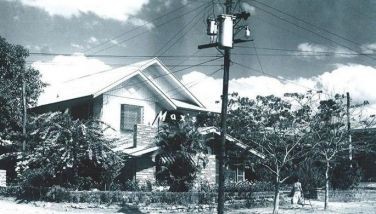The Bangsamoro story

To break away from the current political upheaval against those implicated in the pork barrel scam, allow me to share with you the Bangsamoro story. This will help us understand how the Mindanao problem came to be.
The Philippines has a long history of Moro insurgency movements dating back to the Spanish time. The Muslim population of southwestern Mindanao and the Sulu archipelago strongly resisted colonization. The Muslim struggle was carried over to the American period when the Moros fiercely fought the US troops.
During the late 1960s, violence associated with political disputes, personal feuds and armed gangs flourished. By this time, tension between Moro and Christian communities escalated. By mid-1972 partisan political violence gripped all of Mindanao and the Sulu archipelago.
After Martial Law was declared in September 1972 and when all civilians were ordered to surrender their guns, the Moros rose into arms against the government. At first, they were small isolated uprisings but it became bigger in scope and size. One group, the Moro National Liberation Front, then chaired by Nur Misuari managed to bring most partisan Moro forces into the fold of the loosely unified MNLF.
The MNLF was organized by Abul Khayr Alonto and Jallaludin Santos who were at that time active with the Bangsamoro Movement. The word “Bangsamoro†was coined during the inception of the MNLF. It took two weeks to decide on the name. Abul Khayr insisted on the word “Moroâ€, because that one word carried in itself the history and symbolizes the struggle of the Muslims in the Philippine archipelago. During the Spanish period, the Muslims were called moroz and the Christianized population, indios. Professor Casan Cana, former MSU professor came up with the Malay word “Bangsa†which means nation.
According to Nasser A. Marohomsalic, who wrote Aristocrats of the Malay Race: A History of the Bangsa Moro in the Philippines, in the first two months of 1969, ninety Muslim young men “were secretly shipped to Malaysia and trained for more than a year in Palau Pangkor; forty-one of whom were Maranaos, eighteen Maguindanaons, and thirty-one from Sulu, Zamboanga, Basilan and Tawi-Tawi.â€
They were known as the “Top 90â€. Seven of them secretly organized themselves into a committee to provide leadership for the group. These were Chairman Nur Misuari, Abdul Khayr Alonto, Jimmy Lucman, Caloy Bandaying, Uroh Salahuddin, Ramit Hassan and Salih Walih.
This core group coming from different areas and social standings within the Muslim communities called their aspiration as the Bangsamoro Cause. To redeem the lands of the Moros and create a nation of Moros, they called themselves Bangsamoro Army with the name MNLF. Bangsamoro became a byword and now just as they had envisioned the Moros’ political identity. In the 1924 Declaration of Moro Datus, asserting their independence they referred to themselves as a nation of Moros. In the early 1970s the word Bangsamoro was first used because of the MNLF. Today, Bangsamoro is the Muslim polity of the Philippines.
Marohomsalic further wrote, “After the declaration of Martial Law on September 21, 1972, the membership of the central committee was expanded to include Ahmad ‘Bong’ Sumandal, Ali ‘Clay’ Sansaluna, Amelil ‘Ronnie’ Malguiok, Salamat Hashim, Dimasangkay ‘Dimas’ Pundato and Bian Lay Lim.
The MNLF was the Bangsamoro army during those perilous times. These young men fought valiantly. Alonto came down from the hills in 1976 in the spirit of the Tripoli Agreement. He wrote the blue print of the first autonomous government with Marcos and other Muslim leaders. Marcos signed PD No. 1628 on March 25, 1977 creating an Autonomous Region in Southern Philippines. But still this did not appease the mujahideens. They continued with their revolutionary ideals.
Misuari and Salamat Hashim (from the Top 90 men who trained) may have started out together in the top echelons of the MNLF but by mid-1976 Salamat was already angrily complaining about the Misuari-led Tausog dominance in the MNLF’s Central Committee. Added to this was the lack of representations of Maranaos and Maguindanaoans in the MNLF’s Finance Committee – where large amounts of money were being dispersed at the whim of Misuari and his loyalists.
Salamat was also excluded from the international conferences, despite his being a fluent Arabic-speaker (having studied in Cairo on a Nasser-funded scholarship) and his English-language proficiency.
On December 26, 1977, Salamat broke off with Misuari and raised the banner of the MILF. The rest we all know. The MILF became the dominant force in Mindanao.
In 1986, as CONCON delegate, Senator Ahmad Domocao Alonto was the proponent for the 1986 constitutional framework of the Autonomous Region of Muslim Mindanao (ARMM). But peace remained elusive in the region because war and peace have become a business. As a result, we have the Zambo siege and other incidents of such kind in the past that disrupted the peace in the area.
I asked my friend Ayesha Merdeka, a former graduate of OB Montessori Center who has been researching on the Bangsamoro Cause and the MNLF for more than 22 years, who the leader is of the Bangsamoros? She said, “The Bangsamoro is both the leader and the members while the MNLF and MILF are the agents.†I guess Misuari is trying to pull all non-Muslims and non-Moro to twist this situation into some political struggle for leadership – his leadership.
Ayesha further reminded me that: “The Bangsamoro has an ongoing peace negotiation in Kuala Lumpur with the Philippine government through the MILF. Leadership of the Bangsamoro now lies in the hands of the MILF members. The MNLF on the other hand, as an agent of Bangsamoro also await the outcome of the negotiations.†Well, Misuari had the chance to represent and lead the Bangsamoro in a democratic government when he became governor of the ARMM. But he succumbed to graft and corruption and ended a failure. So, how can he lead the Bangsamoro now?
Life is slowly returning to normal in Zamboanga. But is the Mindanao crisis really over? We will never know what really happened that triggered the incident. Where is Misuari now? What is going to happen to the MNLF members who are now in the custody of the government? What about the peace talks between the government and the MILF? Will there be a sustainable solution to the Bangsamoro plight by 2016?
For so many years now, we have been hoping and praying for peace. But as long as there are well-armed men roving Mindanao beyond the writ of law, we can never have peace.
- Latest
- Trending























